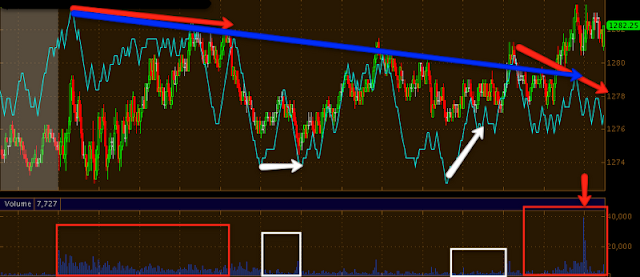I admit that Friday after hours trade is probably the least relevant 4 hours of trade of the week, which is exactly why I watch it. It's well known in media circles, if you want to bury a story, release it Friday night. Thus if there's any funny play, Friday night would be a choice time to conduct it.
DIA AH is pretty quiet
IWM AH has seen some high volume spikes, several times higher then the normal trading hours, which is unusual.
The QQQ has also seen some high volume spikes as well, this is out of the ordinary-we saw it last night and I believe I showed about a week of AH history where the typical volume is so low it's nearly invisible, so the last two days have had that as an unusual occurrence.
The SPY has probably seen the biggest AH volume spike.
Closing trade/volume.
The DIA in EOD trade -the red trendline is Thursday's close, the 2 blue hash marks to the right next to the price levels are the current after hours bid and ask with the last usually being somewhere between them. All of the 4 averages are now trading below today's close as well as yesterday's close. How relevant that is, I don't know, but the AH volume is peculiar.
This is a 15 min chart of the IWM, the very last candle is interesting in that it was the largest volume of the day (institutional money tends to trade actively right near the close) and it tests resistance at yesterday's close and is sent lower, actually lower then the open of the price candle on the highest volume of the day. Again the red trendline depicts Thursday's close.
The QQQ 5 min last candle of the day is also the highest volume and letting go of the previous candle's gains. I can't say this is all that strange going in to the weekend and wouldn't read too much in to it.
Many of the averages formed a triangle today which is classical technical analysis would be considered a consolidation pattern. Because it s symmetrical as opposed to ascending or descending, there is no bias except for the preceding trend that led to it, which in this case would be down. So classical TA would interpret this as a bearish candle, as we know classical TA gets head faked all too often and the break above the apex would be considered the head fake-so long as the triangle resolved to the downside next week. In TA, when you have a pattern like this and you expect it to break down (perhaps you even entered a short on the pattern) and then it breaks up, it is considered a failed pattern and many gurus of TA say you should take the opposite side of the trade, meaning to go long. Over the last several years for those of you who have been here, we see this quite often and the end result is that the pattern is head faked and then plays out to the downside after first sucking in the long buyers. Time will tell if this is another one of those head fake moves.
The 5 and 15 min 3 charts would suggest that it is.
SPY 5 min
SPY 15 min (I wouldn't expect there to be enough time for readings beyond 15 mins.). After hours price would also suggest the same, however with much less weight.
Taking one last look around as things change fast during the time it takes to post, the averages continue to trend down during AH, especially the DIA and the QQQ which would be at a new low if it were not for an earlier candle that had an extremely wide range (you can see that candle in the QQQ AH chart above). The QQQ is trading about $.07 higher then the low of that earlier candle to give you some idea.
Is interest rates about to start going up?
-
Yes, I know - it does not make any sense - FED is about to cut
rates...but....real world interest rates are not always what FED wants it
to be.
6 years ago

























































